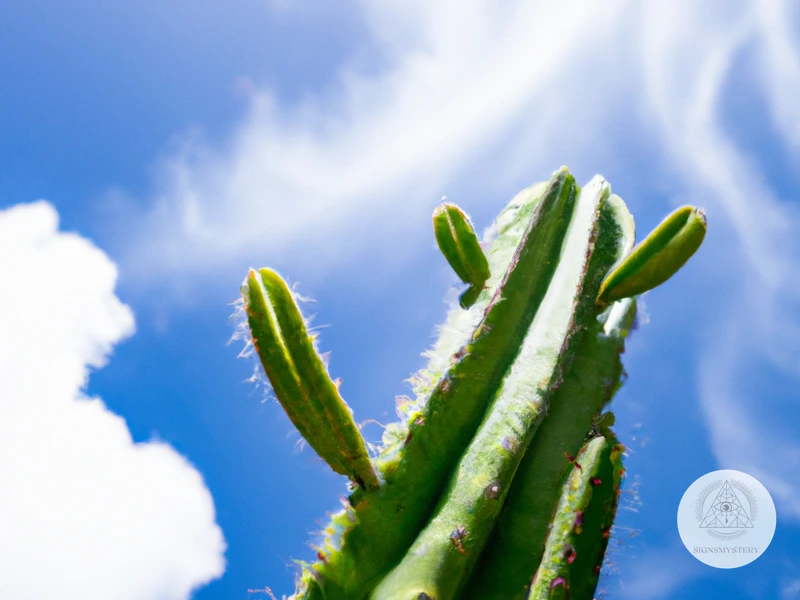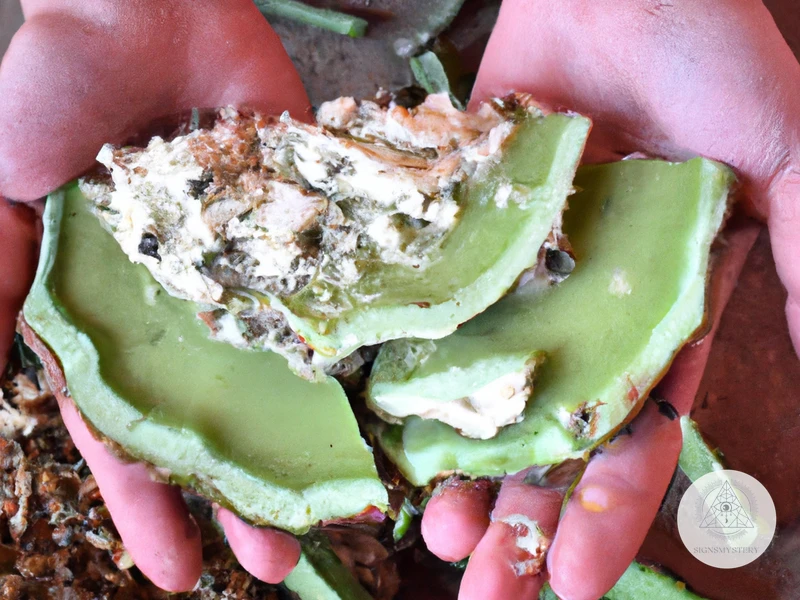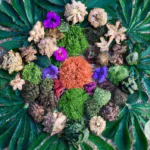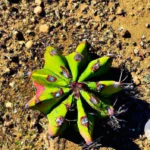San Pedro cactus, also known as Echinopsis pachanoi, is a sacred plant that has been used for centuries by native Andean shamans for its medicinal and spiritual properties. Though it is most commonly known for its psychoactive alkaloids, the cactus also possesses numerous physical health benefits. However, it is important to properly prepare and consume San Pedro cactus to avoid any potential risks or negative experiences. In this article, we will explore the history and properties of San Pedro cactus, as well as step-by-step instructions on how to safely prepare and consume it for medicinal purposes.
About San Pedro Cactus

San Pedro Cactus, which is scientifically known as Echinopsis pachanoi, is a tall, succulent columnar plant that is native to the Andes Mountains. This plant has been used for centuries by the indigenous people of South America for its medicinal and spiritual properties. Its active ingredient, mescaline, is a powerful hallucinogen that can induce altered states of consciousness. San Pedro is often used in shamanic rituals, where it is believed to facilitate communication with the spirit world and promote healing. While San Pedro Cactus is not as well-known as some other plant medicines, such as ayahuasca or peyote, it is becoming increasingly popular among people seeking alternative therapies for physical, mental, and spiritual ailments.
What is San Pedro Cactus
San Pedro Cactus or Echinopsis pachanoi is a species of cactus that grows naturally in the Andean mountains of South America. It is also known by its traditional name, Huachuma, and has been used for centuries by indigenous people for medicinal and spiritual purposes. San Pedro cactus is a tall, columnar cactus that can grow up to six meters high and has a diameter of up to 20 centimeters. It has green-blue needles that are up to eight centimeters in length and can produce a white or pink flower. Here is an overview of some essential information about San Pedro cactus:
| Scientific Name | Echinopsis pachanoi |
|---|---|
| Common Name | San Pedro Cactus, Huachuma |
| Family | Cactaceae |
| Habitat | Andean Mountains of Argentina, Bolivia, Chile, Ecuador, and Peru |
| Availability | Legal in some countries as a decorative plant, but illegal in others for its psychoactive properties |
San Pedro cactus has gained popularity in recent years for its medicinal benefits, and it is becoming more widely available to those interested in its use. However, it is important to note that the use of San Pedro cactus for medicinal or spiritual purposes should only be done under the guidance of a trained and experienced practitioner. Like other plant medicines, such as ayahuasca, tobacco and psilocybin mushrooms, peyote and cannabis, DMT, and many others used in Amazonian plant medicine, it is essential to approach San Pedro cactus use with respect, caution, and proper preparation.
History of San Pedro Cactus Use
San Pedro cactus has been traditionally used in shamanic healing rituals by indigenous tribes in the Andean region of South America for thousands of years. The use of San Pedro in these ceremonies was considered to be a spiritual practice rather than a medicinal one. In addition to its healing properties, the plant was also believed to have sacred qualities that could lead to altered states of consciousness.
San Pedro cactus was first introduced to Western medicine by the German explorer and naturalist Friedrich Ritter in the early 20th century. Ritter was studying the flora and fauna of South America and became interested in the potential medicinal properties of the cactus. He began to experiment with the plant and eventually isolated mescaline, the psychoactive compound found in San Pedro cactus and other cacti.
In the 1950s, San Pedro cactus became more widely known in the West through the work of Harvard ethnobotanist Richard Schultes. Schultes conducted extensive research on traditional plant medicines in the Amazonian region and documented the use of San Pedro cactus in shamanic healing ceremonies.
Today, San Pedro cactus and its psychoactive alkaloids are still used by shamans and spiritual healers in South America and have gained popularity in Western holistic medicine practices. There is a growing body of research that suggests that San Pedro cactus may have potential therapeutic benefits for mental health and addiction treatment.
References:
- Ethics and Sustainability in Plant Medicines and Shamanism
- Plant Medicine for Mental Health and Addiction
Properties of San Pedro Cactus
San Pedro Cactus, also known as Echinopsis pachanoi, is a cactus species native to the Andean mountains of South America. It has been used for centuries by indigenous people for its psychoactive properties.
Alkaloids: The primary active ingredient in San Pedro Cactus is mescaline, a psychoactive alkaloid that causes hallucinations. San Pedro Cactus also contains other alkaloids, including hordenine and tyramine, which may have stimulating effects.
Antioxidants: San Pedro Cactus is also rich in antioxidants, which protect cells from damage caused by free radicals. Antioxidants may also help boost the immune system and reduce the risk of chronic diseases.
Pain Relief: San Pedro Cactus may have analgesic properties, meaning it can reduce pain. This is due to its content of alkaloids, which may act as pain relievers.
Anti-inflammatory: In addition to pain relief, San Pedro Cactus may also have anti-inflammatory properties. This may be beneficial for conditions such as arthritis and other inflammatory diseases.
Mood Enhancement: San Pedro Cactus has been reported to have mood-enhancing effects, boosting feelings of happiness and well-being. This may be due to its effects on dopamine levels in the brain.
Diuretic: San Pedro Cactus may act as a diuretic, helping to increase urine production and flush out toxins from the body.
San Pedro Cactus has a wide range of properties that make it a valuable medicinal plant. Its alkaloids, antioxidants, and anti-inflammatory properties make it useful for pain relief, while its mood-enhancing effects may be beneficial for mental health. However, it is important to consume San Pedro Cactus safely and responsibly to avoid potential risks.
Preparing San Pedro Cactus for Consumption
To prepare San Pedro Cactus for consumption, there are several steps to follow to ensure safety and efficacy. First, it is important to harvest the cactus at the right time, typically in the early morning while it is still fresh. Once harvested, the cactus should be cleaned thoroughly to remove any dirt or debris. Cutting the cactus into small pieces and removing the spines is also crucial. After preparation, the cactus should be dried in a well-ventilated area away from direct sunlight. It can then be stored in an airtight container until ready for consumption. Properly preparing San Pedro Cactus is important to unlock its potential medicinal benefits for physical and mental health.
Harvesting San Pedro Cactus
When it comes to harvesting San Pedro Cactus, there are a few things to keep in mind in order to ensure that you have a safe and effective product. Here are some tips on how to harvest San Pedro Cactus:
- Choose the Right Time: Harvest San Pedro Cactus during the warmer months, when they are actively growing. The best time to harvest the cactus is in the late spring or early summer, when the temperature is mild but not too hot. This will ensure that the cactus is at its healthiest and most potent.
- Wear Protective Gear: When harvesting San Pedro Cactus, be sure to wear protective gear, such as rubber gloves and long sleeves, as the cactus has spines that can cause injury. Use a pair of tongs or pliers to handle the cactus safely.
- Look for Healthy Cactus: Choose cacti that are healthy and free of damage or disease. Look for cacti that are firm, with no soft spots, discoloration, or browning. The cactus should be green and have a plump and healthy appearance.
- Use a Sharp Knife: Use a sharp knife to cut the cactus at a 45-degree angle, about one foot above the ground. This will help to minimize damage to the cactus and allow it to heal quickly.
- Leave Enough Plant: When harvesting San Pedro Cactus, it is important to leave enough plant behind so that it can continue to grow and thrive. A good rule of thumb is to leave at least two-thirds of the plant intact.
By following these guidelines, you can ensure that you are harvesting your San Pedro Cactus in a safe and sustainable way, and that you are able to reap the maximum benefits from this powerful medicinal plant.
Cleaning and Cutting San Pedro Cactus
Cleaning and cutting San Pedro cactus is an essential step in preparing it for consumption. The first thing you need to do is to remove the spines from the cactus. This can be done with a sharp knife, a pair of tweezers, or a vegetable peeler. Be careful not to leave any spines behind, as they can cause irritation and discomfort when consumed.
Once all the spines are removed, you can wash the cactus thoroughly with water. Use a scrub brush or a soft cloth to remove any dirt or debris that may be stuck on the surface. Avoid using any soap or detergent as they can leave a residue that may affect the medicinal properties of the cactus.
After cleaning, it is time to cut the cactus into small pieces. You can use a sharp knife or a pair of kitchen scissors for this. Cut the cactus into small pieces, no larger than 1 inch in thickness. This will make it easier to grind and prepare.
When cutting the cactus, avoid using the top part that contains the flowering buds. It is recommended to use the middle part of the cactus, as this is where the highest concentration of medicinal alkaloids is found.
After cutting the cactus, spread it out on a clean surface or a baking sheet and allow it to dry completely. This can take anywhere from 1 to 3 days. Make sure to turn the pieces frequently to ensure even drying.
Cleaning and cutting San Pedro cactus may seem like a tedious process, but it is necessary to ensure its safe and effective consumption. Taking the time to properly prepare the cactus will enhance its medicinal benefits and prevent any potential health risks.
Drying and Storing San Pedro Cactus
After cleaning and cutting the San Pedro cactus, it is important to properly dry and store it before consumption. Drying the cactus not only preserves it but also intensifies its potency. The drying process can take anywhere from several days to a week depending on the environment and humidity levels.
The first step in drying the San Pedro cactus is to cut it into thin strips. Take caution when handling the cactus as it may still contain some of its natural spines which could cause injury. Then, lay the strips on a clean surface out of direct sunlight and let them air dry. Turn the strips over every few hours to ensure they dry evenly. Alternatively, a dehydrator can be used to speed up the process if available.
Once the strips are completely dry, store them in an airtight container. Glass jars with tight-fitting lids work exceptionally well for this purpose. It is best to keep the container in a cool, dry, and dark place like a pantry or a cupboard. Properly dried and stored San Pedro cactus can last for months without losing potency.
It is essential to keep in mind that the potency of the San Pedro cactus can vary depending on how it was grown, harvested, and prepared. It is crucial to accurately identify the species and source of the cactus before using it for medicinal purposes. Always ensure that the cactus has been grown without the use of pesticides and other harmful chemicals.
Consuming San Pedro Cactus

Consuming San Pedro Cactus requires careful preparation and consideration. Traditional methods of consumption include making a brew with the dried or fresh cactus, which can be quite bitter. Some people choose to add honey or other natural sweeteners to mask the taste. Another popular method is to blend the cactus into a smoothie with other fruits or vegetables. It’s important to remember that San Pedro Cactus contains mescaline, a psychoactive compound that can have powerful effects on the mind and body. It’s crucial to adhere to the recommended dosage and start with a small amount to gauge personal sensitivity. Precautions for safe consumption include ensuring that the cactus has been properly cleaned and prepared. Potential risks of San Pedro Cactus consumption can include nausea, vomiting, and even dangerous increases in blood pressure. It’s essential to approach San Pedro Cactus with respect and reverence, taking the time to prepare and consume it in a safe and mindful manner.
Traditional Methods of Consumption
Traditional methods of consumption of San Pedro cactus have been used by indigenous peoples for centuries. One of the most common methods is boiling the cactus and drinking the resulting brew, known as a “tea.” To make this tea, sections of the cactus are cut and boiled with water for several hours until the liquid has reduced. The resulting brew is consumed and can be quite bitter, so it is often combined with other herbs or sweeteners to improve the taste.
Another traditional method of consuming San Pedro cactus is through chewing. The fresh cactus is cut into small pieces and chewed thoroughly until all the juices are extracted. This can be a difficult and unpleasant method of consumption due to the bitter taste and tough texture of the cactus.
In some cultures, San Pedro cactus is also consumed in the form of a “mescaline paste.” This paste is made by grinding the dried cactus into a powder, mixing it with water to create a paste, and then shaping it into small balls that are then dried in the sun. The paste can be consumed directly or mixed with other herbs or decoctions.
While these traditional methods of consumption have been used for centuries, it is important to note that they may not be suitable for everyone. Careful preparation and dosing are critical to ensure physical and mental safety when consuming San Pedro cactus. It is also important to note that these methods may not be legal or accessible in all areas, so it is crucial to do your research and exercise caution.
Recommended Dosage of San Pedro Cactus
Determining the appropriate dose of San Pedro cactus can be a complicated process. The psychedelic properties of this cactus can produce unpredictable effects, especially for novice users. It is important to approach the consumption of San Pedro cactus with caution and mindfulness.
The recommended dosage of San Pedro cactus depends on several factors, such as age, weight, metabolism, sensitivity, and overall health. In general, the optimal dose may vary between 20 and 100 grams of fresh San Pedro cactus or 1 to 4 grams of dried cactus powder. However, these amounts should be adjusted based on the individual’s tolerance and experience.
To minimize the risk of adverse effects, it is advisable to start with a low dose and gradually increase it over time. For example, a beginner may start with 20 grams of fresh San Pedro cactus and wait for at least 2 hours to evaluate the effects before consuming more. If the effects are too mild, another 10-20 grams
Subscribe to Our Newsletter
Sign up to receive the latest news and updates.
It is also essential to consider the potency and quality of the cactus, as it can vary depending on the species, source, and preparation method. It is recommended to obtain San Pedro cactus from a reputable and experienced supplier who can ensure its purity and authenticity.
The following table summarizes the recommended dosage range for San Pedro cactus for different levels of experience:
| Experience Level | Fresh San Pedro Cactus (grams) | Dried San Pedro Cactus Powder (grams) |
|——————|——————————–|—————————————-|
| Beginner | 20-40 | 1-2 |
| Intermediate | 40-60 | 2-3 |
| Advanced | 60-100 | 3-4 |
It is important to note that the effects of San Pedro cactus can last for 6 to 12 hours or more, so users should plan their consumption accordingly. It is also recommended to have a sober and responsible sitter who can provide support and assistance during the experience.
By following these guidelines for recommended dosage and consuming San Pedro cactus mindfully, users can potentially experience the physical, mental, and spiritual benefits of this powerful medicinal plant.
Precautions for Safe Consumption
When it comes to consuming San Pedro Cactus, there are a few precautions that should be taken to ensure a safe and positive experience. Here are some important things to keep in mind:
| Precaution | Explanation |
| Research Dosage | It’s important to know the correct dosage of San Pedro Cactus for your body, as taking too much can lead to negative side effects. Start with a small amount and work your way up. |
| Find a Safe Environment | Make sure that you are in a safe space where you won’t be disturbed during your San Pedro Cactus experience. It’s also a good idea to have someone with you who can watch over you and make sure that you’re okay. |
| Avoid Alcohol and Drugs | Alcohol and drugs can interact negatively with San Pedro Cactus. It’s best to avoid these substances in the days leading up to your San Pedro Cactus experience. |
| Stay Hydrated | San Pedro Cactus can cause dehydration, so it’s important to drink plenty of water before, during, and after your experience. |
| Avoid Driving | San Pedro Cactus can impair your ability to drive and operate machinery. Stay in one place and avoid driving until the effects have worn off completely. |
| Avoid Mixing with Medications | If you’re taking medications, it’s important to talk to your doctor before consuming San Pedro Cactus. Some medications can interact negatively with San Pedro Cactus, so it’s best to err on the side of caution. |
| Know the Source | Make sure that you’re getting your San Pedro Cactus from a trusted source. This can help to ensure that the cactus is pure and hasn’t been contaminated with harmful substances. |
Taking these precautions can help you to have a safe and positive experience with San Pedro Cactus. Remember to always listen to your body and stop consuming if you feel uncomfortable or experience any negative side effects.
Potential Risks of San Pedro Cactus Consumption
It’s important to understand the potential risks of consuming San Pedro cactus. Despite its beneficial properties, there are a number of potential side effects to be aware of. Perhaps the most immediate concern is the possibility of an adverse reaction to the mescaline compound found within the cactus. Mescaline can cause a range of physical and psychological symptoms, including nausea, vomiting, diarrhea, and dizziness, as well as more serious side effects such as heart palpitations, high blood pressure, and even seizures. It’s worth noting that these symptoms are generally more likely to occur at higher doses.
Another potential risk of consuming San Pedro cactus is the possibility of a negative interaction with other medications. San Pedro cactus can interact with a number of prescription drugs, including antidepressants, antipsychotics, and blood pressure medications, potentially leading to dangerous side effects. As always, it’s important to discuss any potential drug interactions with your doctor before consuming San Pedro cactus.
Finally, it’s worth highlighting the fact that the consumption of San Pedro cactus is illegal in some countries, and can result in legal repercussions if caught. As with any substance, it’s important to be informed and aware of the legal landscape in your locality.
It’s important to approach the consumption of San Pedro cactus with caution and an understanding of the potential risks involved. While it can offer numerous physical and psychological benefits, it’s always important to weigh those benefits against the potential risks to ensure a safe and enjoyable experience.
The Medicinal Benefits of San Pedro Cactus
San Pedro Cactus, also known as Echinopsis pachanoi, has long been revered by indigenous cultures for its medicinal properties. The cactus contains a variety of alkaloids, including mescaline, which is known for its psychoactive effects. Beyond its use in traditional spiritual ceremonies, San Pedro Cactus has also been studied for its potential medicinal benefits. Some physical benefits believed to be associated with San Pedro Cactus consumption include pain relief, anti-inflammatory properties, and even potentially tumor-fighting properties. Additionally, San Pedro Cactus has been known to offer mental and spiritual benefits such as enhanced creativity, improved mood, and increased sense of connectedness. While more research is needed to fully understand the range of medicinal benefits of San Pedro Cactus, its use in traditional medicine and growing interest in its properties demonstrate its potential as a powerful therapeutic tool.
Physical Benefits
San Pedro cactus contains a number of alkaloids, including mescaline, which gives the cactus its psychoactive effects. But it also contains other beneficial compounds that can provide physical healing benefits.
Here are some of the physical benefits associated with San Pedro cactus consumption:
| Physical Benefit | Description |
|---|---|
| Pain relief | San Pedro cactus has long been used as a natural pain reliever to help with conditions like headaches, arthritis, menstrual cramps, and nerve pain. |
| Anti-inflammatory properties | The cactus contains compounds that exhibit anti-inflammatory properties and are effective against conditions like asthma, allergies, and skin irritations. |
| Boosts immune system | Research suggests that San Pedro cactus can stimulate white blood cell production, which boosts our immune systems and helps our bodies fight off diseases and infections. |
| Reduces high blood pressure | Studies have shown that San Pedro cactus can help lower high blood pressure. One of the ways it does this is by promoting more efficient blood circulation in the body. |
| Improves digestion | San Pedro cactus can act like a natural laxative, aiding in the healthy elimination of waste. It can also help reduce symptoms of acid reflux and stomach ulcers. |
It’s important to note that while San Pedro cactus can offer these physical benefits, it should not be used as a substitute for professional medical care. Always consult with a healthcare provider before taking San Pedro cactus for medicinal purposes.
Mental and Spiritual Benefits
San Pedro Cactus is also known for its mental and spiritual benefits, which have been utilized by indigenous cultures for centuries. The plant contains mescaline, which is the primary psychoactive compound responsible for these benefits.
Mental Benefits:
– Reduction in anxiety and depression: Mescaline has been shown to have a positive effect on mood and can help to alleviate symptoms of anxiety and depression.
– Increased creativity and productivity: Some people report that San Pedro Cactus consumption can help to increase their creativity and productivity levels, making it a popular choice for artists and writers.
– Improved cognitive abilities: Mescaline can also enhance cognitive abilities such as problem-solving, decision-making, and memory.
Spiritual Benefits:
– Enhanced spiritual experiences: San Pedro Cactus has long been used in spiritual ceremonies, where it is believed to enhance spiritual experiences and facilitate communication with the divine.
– Increased self-awareness: Many people report that consuming San Pedro Cactus can help to increase their self-awareness and understanding of their place in the world.
– Connection with nature: The plant is also said to foster a greater connection with nature and the environment, which can lead to a deeper appreciation for the natural world.
It is important to note that the mental and spiritual benefits of San Pedro Cactus consumption should always be approached with caution and respect. It is recommended to consume the plant under the guidance of an experienced practitioner in a safe and controlled environment.
Conclusion
In conclusion, the San Pedro Cactus has a long history of traditional medicinal use in South America. It contains a powerful psychoactive substance known as mescaline, which is responsible for its therapeutic effects.
Preparing and consuming San Pedro Cactus can be a safe process if done correctly, however, it’s important to understand the potential risks and precautions associated with its use. It’s crucial to source the cactus from a reputable seller and to follow proper harvesting, cleaning, cutting, drying, and storing techniques.
Traditional methods of consumption include making a tea or chewing the fresh or dried cactus, but it’s important to pay attention to the recommended dosage to avoid potential negative effects such as nausea, vomiting, and hallucinations.
The medicinal benefits of San Pedro Cactus are vast, and can include physical benefits such as pain relief and anti-inflammatory properties, as well as mental and spiritual benefits such as improved mood, creativity, and spiritual insight.
It’s important to note that San Pedro Cactus should only be consumed under the supervision of a qualified healthcare professional or experienced shaman, and should not be used as a substitute for professional medical treatment.
Overall, if used correctly, San Pedro Cactus can be a powerful tool for medicinal and spiritual purposes, providing an opportunity for self-exploration and healing.
Frequently Asked Questions
How long does it take for San Pedro Cactus to take effect?
The effects of San Pedro Cactus can take anywhere from 45 minutes to 3 hours to be felt.
What is the best time of day to consume San Pedro Cactus?
It is recommended to consume San Pedro Cactus during daylight hours, preferably early in the morning.
Can San Pedro Cactus be consumed alone or should it be done with a guide?
While it is possible to consume San Pedro Cactus alone, it is highly recommended to have a knowledgeable guide present to ensure a safe and positive experience.
How much San Pedro Cactus should I consume?
The recommended dosage of San Pedro Cactus is anywhere from 20 to 200 grams, depending on the individual’s tolerance and experience level.
Is it safe to mix San Pedro Cactus with other substances?
It is not recommended to mix San Pedro Cactus with other substances, as this can increase potential risks and negative side effects.
What are the potential risks of consuming San Pedro Cactus?
Potential risks include nausea, vomiting, diarrhea, anxiety, and even psychosis in rare cases.
What is the difference between San Pedro Cactus and Peyote?
San Pedro Cactus and Peyote are both species of cactus containing mescaline, but Peyote is much smaller and typically has a stronger psychoactive effect.
Can San Pedro Cactus be used to treat anxiety and depression?
There is potential for San Pedro Cactus to be used as a tool for treating anxiety and depression, but further research is needed before any definite conclusions can be made.
How long does a San Pedro Cactus trip typically last?
A San Pedro Cactus trip can last anywhere from 6 to 15 hours, depending on the individual’s dose and experience level.
Is San Pedro Cactus legal?
The legality of San Pedro Cactus varies by country and region, so it is important to do research and understand local laws before consuming or possessing this plant.










